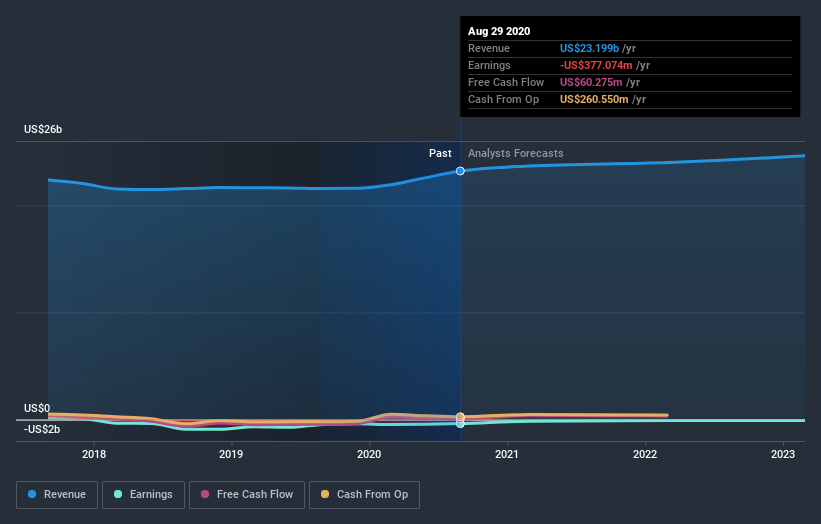Rite Aid Corporation (NYSE:RAD) Just Reported, And Analysts Assigned A US$8.13 Price Target

Shareholders in Rite Aid Corporation (NYSE:RAD) had a terrible week, as shares crashed 26% to US$10.00 in the week since its latest quarterly results. Revenues of US$6.0b beat expectations by a respectable 4.3%, although statutory losses per share increased. Rite Aid lost US$0.25, which was 151% more than what the analysts had included in their models. Following the result, the analysts have updated their earnings model, and it would be good to know whether they think there's been a strong change in the company's prospects, or if it's business as usual. So we gathered the latest post-earnings forecasts to see what estimates suggest is in store for next year.
See our latest analysis for Rite Aid
Taking into account the latest results, the most recent consensus for Rite Aid from five analysts is for revenues of US$23.7b in 2021 which, if met, would be a credible 2.0% increase on its sales over the past 12 months. The loss per share is expected to greatly reduce in the near future, narrowing 58% to US$2.95. Before this latest report, the consensus had been expecting revenues of US$23.5b and US$1.33 per share in losses. So it's pretty clear the analysts have mixed opinions on Rite Aid even after this update; although they reconfirmed their revenue numbers, it came at the cost of a per-share losses.
The consensus price target fell 32% to US$8.13per share, with the analysts clearly concerned by ballooning losses. The consensus price target is just an average of individual analyst targets, so - it could be handy to see how wide the range of underlying estimates is. The most optimistic Rite Aid analyst has a price target of US$13.00 per share, while the most pessimistic values it at US$4.00. As you can see the range of estimates is wide, with the lowest valuation coming in at less than half the most bullish estimate, suggesting there are some strongly diverging views on how analysts think this business will perform. With this in mind, we wouldn't rely too heavily the consensus price target, as it is just an average and analysts clearly have some deeply divergent views on the business.
Another way we can view these estimates is in the context of the bigger picture, such as how the forecasts stack up against past performance, and whether forecasts are more or less bullish relative to other companies in the industry. One thing stands out from these estimates, which is that Rite Aid is forecast to grow faster in the future than it has in the past, with revenues expected to grow 2.0%. If achieved, this would be a much better result than the 5.1% annual decline over the past five years. Compare this against analyst estimates for the wider industry, which suggest that (in aggregate) industry revenues are expected to grow 3.2% next year. Although Rite Aid's revenues are expected to improve, it seems that the analysts are still bearish on the business, forecasting it to grow slower than the wider industry.
The Bottom Line
The most important thing to note is the forecast of increased losses next year, suggesting all may not be well at Rite Aid. Fortunately, the analysts also reconfirmed their revenue estimates, suggesting sales are tracking in line with expectations - although our data does suggest that Rite Aid's revenues are expected to perform worse than the wider industry. The consensus price target fell measurably, with the analysts seemingly not reassured by the latest results, leading to a lower estimate of Rite Aid's future valuation.
Keeping that in mind, we still think that the longer term trajectory of the business is much more important for investors to consider. We have forecasts for Rite Aid going out to 2023, and you can see them free on our platform here.
Plus, you should also learn about the 2 warning signs we've spotted with Rite Aid (including 1 which shouldn't be ignored) .
This article by Simply Wall St is general in nature. It does not constitute a recommendation to buy or sell any stock, and does not take account of your objectives, or your financial situation. We aim to bring you long-term focused analysis driven by fundamental data. Note that our analysis may not factor in the latest price-sensitive company announcements or qualitative material. Simply Wall St has no position in any stocks mentioned.
Have feedback on this article? Concerned about the content? Get in touch with us directly. Alternatively, email editorial-team@simplywallst.com.



